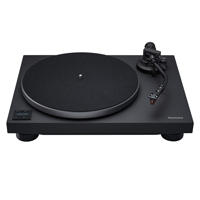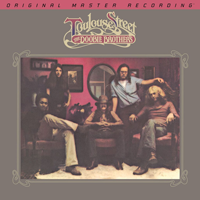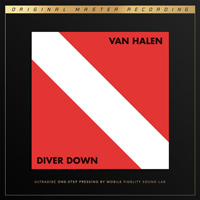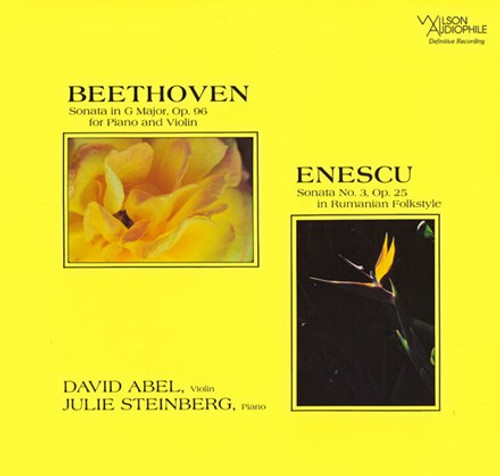Beethoven Violin Sonata Op.96 and Enescu: Op. 25 - David Abel - Julie Steinberg (200g Vinyl LP)
Full Details
Beethoven Violin Sonata Op. 96 and Enescu Op. 25 (Abel, Steinberg) on 200g LP from Analogue Productions: Remastered by Kevin Gray at Cohearent Audio and Pressed at QRP
World-class musicians - violinist David Abel and pianist Julie Steinberg - masterfully perform Beethoven's Sonata in G Major, Op. 96 and Enescu's Sonata No. 3, Op. 25 under the pristine production guidance of David Wilson. Abel on recording with Wilson, "The session was free of the time pressure and tension that can really get in the way of the final outcome...Dave kept open to what was happening in the moment, as in a concert. He understood about not making a 'perfect' recording, and instead left the small imperfections...that make the final result sound human and real. One could not ask for better." Wison adds, "I'd put the recording up against any chamber music recording. It has to be my favorite."
The former composition occupies a special place among Beethoven's creations because it shows a unique quality: there is an Olympian elegance, a profound gentleness that pervades the entire work. Nowhere does Beethoven the earth shaker appear. Even the scherzo movement does not disturb this sustained thoughtfulness. Violin and piano begin trading short thematic statements in quick exchange from the first notes of the first movement. Parallel arpeggios create a growing intensity. The middle section of the movement is characterized by abrupt modulations and an increased pace of exchanges. A striking procedure is the use of a seemingly interminable trill, nearly heart-stopping in its intensity.
The second movement, Adagio expressivo, one of Beethoven's floating Adagios, is based on the compulsion of a slow intense bass movement. The serenity of this movement is not disturbed by elaborate decoration from both instruments. And this stillness is further emphasized by a fourteen measure repeating pedal point (nearly one fifth of the movement) which closes it. The Scherzo sustains the serious character of the entire work. The last movement begins not only with a quick alternation of themes between the violin and piano, but a soft and loud alternation, as well, which adds to the feeling of growing intensity. An interrupted rondo is the plan, but the interruptions are of a major kind: another sensuous adagio and a daring fugato lead to a presto outburst concluding the movement.
Enescu absorbed the folk styles of his country in all of their complexity. He found slides, microtones, augmented seconds, insistent repeated notes played on the cimbalom, drone effects, free rhythms, four and five note gapped scales, tone patterns that repeat over and over (ostinatos). Important notes in melodies were approached by a fast swarming over neighboring notes. All of these devices Enescu appropriated along with the very special folk harmonies based on chords built of as many as five consecutive thirds and of rhythms derived partly from the complexities of spoken Rumanian (termed parlando-rubato in a study of this style made by Bela Bartok), and partly from the special technical features that were used by native Rumanian instruments. Heavy accents which occur frequently in this composition were taken from the strong footfalls of folk dance.
Musicians:
Ludwig van Beethoven / George Enescu, composer
David Wilson, producer
David Abel, violin
Julie Steinberg, piano
Features:
• 200g vinyl pressing from Analogue Productions
• Remastered by Kevin Gray at Cohearent Audio
• Plated and pressed at Quality Record Pressings
Track Listing
- Violin Sonata No.10 in G Major, Op. 96 – I. Allegro moderato
- Violin Sonata No.10 in G Major, Op. 96 – II. Adagio espressivo
- Violin Sonata No.10 in G Major, Op. 96 – III. Scherzo Allegro
- Violin Sonata No.10 in G Major, Op. 96 – IV. Poco allegretto
- Violin Sonata No. 3 in A Minor, Op. 25, "Dans le caractere populaire roumain" - I. Moderato malinconico
- Violin Sonata No. 3 in A Minor, Op. 25, "Dans le caractere populaire roumain" – II. Andante sostenuto e misterioso
- Violin Sonata No. 3 in A Minor, Op. 25, "Dans le caractere populaire roumain" – III. Allegro con brio, ma non troppo mosso





































